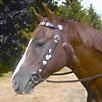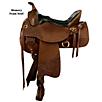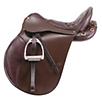I know I said I'd go in order of the comments/ questions for my animal posts, but I thought I'd take a break every now and then and post about horses, because I have SO MUCH information on them.
Horses are kind of my bread and butter. I love them; have ever since my dad promised my sister and me that we would get one when I was eight. We even met the horse and named him (Zeus), but alas, we moved into the city shortly thereafter, and Zeus found another home.
I therefore begged my parents at every opportunity (birthdays, Christmas, Easter, Halloween, Arbor Day, Columbus Day, and occasional fourth of Julys) to get me a horse. Finally, in the seventh grade, my mom caved and got me riding lessons. I suppose she was hoping I would figure out I didn't really like them, or get it out of my system and leave them alone.
Nope. Also, no ponies under the Christmas tree. Finally, after several summers of working my way into riding lessons at various ranches around the county, I found a place to stay the summer after my senior year, and that's where I met my first (and eventual second) horse. I bought both of them with my own money, albeit five years apart, and continued to pay for them on my own.
Having my own horse(s) has taught me more about horses than anything else I've done. And I now fact-check horses EVERYWHERE. In movies, and in books, and anywhere else they might show up. It's a habit. And when I find mistakes, I tend to correct them, as any of my crit partners can tell you. So I thought I'd start with a Writer's Beginning Guide to Horses today, and get some basic terms and concepts out of the way.
(All of the following pictures come from statelinetack.com).
We'll start with accoutrements, commonly called tack. This includes just about anything a horse would wear for riding/ being ridden. I'll start with this because I find that tack is the thing most often messed up in fiction related to horses. That and gaits, but we'll get to those another time.
Halter: A halter is usually leather, rope, or nylon webbing with metal rings. It fits around the horse's face and throat, applying pressure on the nose and behind the ears (the poll). A halter is used to lead a horse.
I apologize this picture is so absolutely tiny. You get the gist, though, right?
Anyway, halters are most often confused with the bridle. The bridle is what's typically used for riding a horse, is made of leather, and has a bit, which is a metal piece that goes into the horse's mouth. The bit is used to control the direction and speed of the horse, though not exclusively. (As with anything about animals, there's a lot else I could go into here. We'll assume any riders in your books are going to be doing things the traditional way, and if you ever have any questions about advanced techniques or the what-ifs, feel free to email me). The bit is attached to reins, usually also leather, but can be nylon or rope, which the rider holds in their hands and pulls on in one direction or another to get the horse to turn, or both together to get the horse to slow down or stop.
This is a western bridle:

Source
Make sure your tack matches. If you're writing a cowboy or wild west novel set in the States, or a ranch novel, well, you probably know enough about horses that you don't need to read this. But, those novels would likely use Western tack. If you're setting it in England or Europe, or the East coast of the States, you'll likely need English tack.
Western and English bridles are very similar, they mostly make different uses of pressure (an English bridle often has a band that wraps around the nose, like a halter, whereas a Western bridle can have a curb strap that passes under the chin) and different bits. I won't go into bits today. Again, if you really need to know, email me.
Saddles: There are three primary types of saddles in use today. There's the Western, which is commonly used for long trail rides and working cattle. It's more of a "comfort" saddle, and has built-in features to help keep the rider on the horse:

Western and English bridles are very similar, they mostly make different uses of pressure (an English bridle often has a band that wraps around the nose, like a halter, whereas a Western bridle can have a curb strap that passes under the chin) and different bits. I won't go into bits today. Again, if you really need to know, email me.
Saddles: There are three primary types of saddles in use today. There's the Western, which is commonly used for long trail rides and working cattle. It's more of a "comfort" saddle, and has built-in features to help keep the rider on the horse:

Source
English saddles are used for English riding, which most famously includes the "high disciplines" like dressage (horse dancing, if you will-- means training in French), and jumping. They put you closer to the horse and allow them to feel your movements more effectively, but it can require more balance on the part of the rider, at least on a beginning level:


Source
And the Australian stock saddle, which is sort of a combination of the two. It allows for the same close contact with the horse as the English saddle while giving the comfort and stability of the Western saddle:

Source

Source
Australian stock saddles have only become popular in the United States in the last 10-15 years or so, at least to my knowledge. But it's a design that's likely very similar to some historical saddles, which are a whole other ballgame.
So that's pretty much it for my most basic of basics beginning guide to tack. Any questions?
So that's pretty much it for my most basic of basics beginning guide to tack. Any questions?

No questions, but I'm totally bookmarking this for when I get back to my historical fantasy. I think my MC is going to be a horsey person. Like you!! Wait, that doesn't sound right... :) :)
ReplyDeleteWhat I'm wondering about is how old these words are. By that, I mean have the accouterments always been called "tack" or is that relatively new?
ReplyDelete(I ask because my MCs in SON OF MAGIC live in a pseudo-14th century world.)
My mom always laughs when anyone walks into a stable in movies, tv, books, etc. and the horses are all talking to that person and talking to each other. (Nickering, etc.) They don't do that in real life. Really, with our horses at least, it's an honor not readily bestowed if they whinny or nicker at you when you walk in the barn.
ReplyDeleteMostly it's them saying, "Finally the food is on the way!"
Elana-- bookmark away :) I'm glad it will be useful. And I know what you meant. I look like a giraffe.
ReplyDeleteMatt- That's a really good question. I'll have to look into it; I believe most of these words are pretty old, at least dating back to the middle ages, but I'm not 100%, that's for certain. There have been several opportunities for the words to arise that I can think of so I can't name their sources off the top of my head. However-- since the characters in your book would be speaking English, even a modified version to represent the era, it would still be modern English and therefore you could use these words; it's like a translation, if you will.
Stephanie-- so true! I've had my current horse for three years now and she's JUST NOW starting to whinny at me when I walk up to her stall. And it still doesn't happen very often. She has to be very lonely or very hungry to get that out of her.